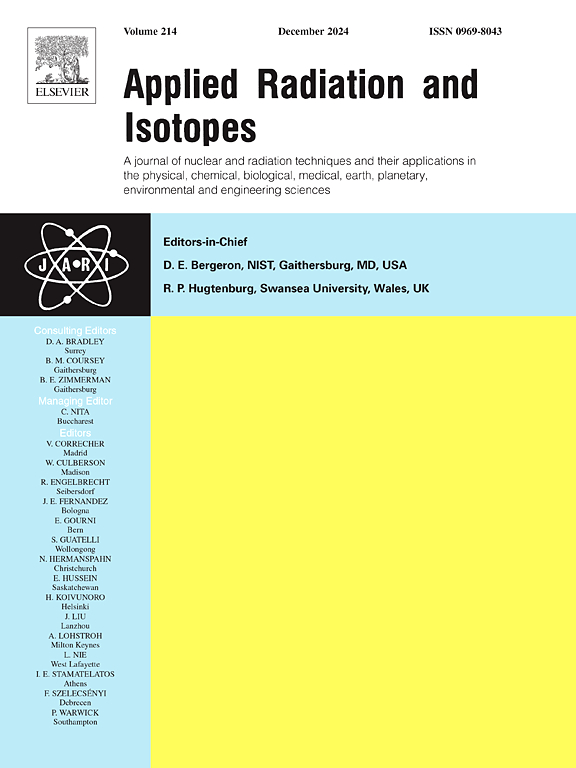Development of a silicon carbide radiation detection system and experimentation of the system performance
IF 1.6
3区 工程技术
Q3 CHEMISTRY, INORGANIC & NUCLEAR
引用次数: 0
Abstract
Silicon carbide (SiC) detectors have excellent radiation detection capabilities for various radiation particles, including high energy resolution, fast response times, and good radiation resistance. A SiC radiation detection system was developed to measure the neutron fluence rate and the γ-ray dose rate in high intensity radiation fields. The system was composed of two SiC detectors, a temperature monitor, two preamplifiers for each SiC detector, a data acquisition unit with two signal channels, three pairs of communication devices, and an application software to analyze and visualize the measurement data. The two SiC detectors were fabricated based on two kinds of 4H-SiC diodes and used to respectively respond to neutrons and γ-rays. Repeated experiments showed that the two SiC detectors of the system can respond to α-particles, neutrons, and γ-rays. To verify the performance of the SiC detection system, including the response linearity of the neutron fluence rate, the measurement range of the γ-ray dose rate, and the radiation resistance of the SiC radiation detectors, the system was tested in multiple neutron and γ-ray fields. The tests results show the system can measure the neutron fluence rate from 5.64 × 10 2 cm−2 s−1 to 1.03 × 10 5 cm−2 s−1 with excellent linearity response, and the γ-ray dose rate from 0.005 Gy/h to 20 Gy/h. Furthermore, the SiC detectors demonstrated good radiation resistance. The neutron and γ-ray radiation field can still be measured stably by the system after exposure to neutron fluence of 1.07 × 10 14 cm−2 and γ-ray dose of 3.52 × 10 4 Gy. This work is the preliminary research to continue the exploration how to measure the n/γ hybrid fields accurately using SiC detectors considering the different energy of neutrons.
开发碳化硅辐射探测系统并进行系统性能实验
碳化硅(SiC)探测器对各种辐射粒子具有出色的辐射探测能力,包括高能量分辨率、快速响应时间和良好的抗辐射能力。我们开发了一种碳化硅辐射探测系统,用于测量高强度辐射场中的中子通量率和γ射线剂量率。该系统由两个碳化硅探测器、一个温度监测器、每个碳化硅探测器的两个前置放大器、一个具有两个信号通道的数据采集单元、三对通信设备以及一个用于分析和显示测量数据的应用软件组成。两个 SiC 探测器是基于两种 4H-SiC 二极管制造的,分别用于响应中子和 γ 射线。反复的实验表明,该系统的两个 SiC 探测器可以对 α 粒子、中子和 γ 射线做出响应。为了验证 SiC 检测系统的性能,包括中子通量率的响应线性、γ 射线剂量率的测量范围以及 SiC 辐射探测器的抗辐射能力,该系统在多个中子和γ 射线场中进行了测试。测试结果表明,该系统可测量 5.64 × 10 2 cm-2 s-1 至 1.03 × 10 5 cm-2 s-1 的中子通量率,线性响应极佳;可测量 0.005 Gy/h 至 20 Gy/h 的γ射线剂量率。此外,碳化硅探测器还具有良好的抗辐射能力。该系统在受到 1.07 × 10 14 cm-2 的中子通量和 3.52 × 10 4 Gy 的γ射线剂量照射后,仍能稳定地测量中子和γ射线辐射场。这项工作是继续探索如何利用碳化硅探测器准确测量不同能量中子的 n/γ 混合场的初步研究。
本文章由计算机程序翻译,如有差异,请以英文原文为准。
求助全文
约1分钟内获得全文
求助全文
来源期刊

Applied Radiation and Isotopes
工程技术-核科学技术
CiteScore
3.00
自引率
12.50%
发文量
406
审稿时长
13.5 months
期刊介绍:
Applied Radiation and Isotopes provides a high quality medium for the publication of substantial, original and scientific and technological papers on the development and peaceful application of nuclear, radiation and radionuclide techniques in chemistry, physics, biochemistry, biology, medicine, security, engineering and in the earth, planetary and environmental sciences, all including dosimetry. Nuclear techniques are defined in the broadest sense and both experimental and theoretical papers are welcome. They include the development and use of α- and β-particles, X-rays and γ-rays, neutrons and other nuclear particles and radiations from all sources, including radionuclides, synchrotron sources, cyclotrons and reactors and from the natural environment.
The journal aims to publish papers with significance to an international audience, containing substantial novelty and scientific impact. The Editors reserve the rights to reject, with or without external review, papers that do not meet these criteria.
Papers dealing with radiation processing, i.e., where radiation is used to bring about a biological, chemical or physical change in a material, should be directed to our sister journal Radiation Physics and Chemistry.
 求助内容:
求助内容: 应助结果提醒方式:
应助结果提醒方式:


